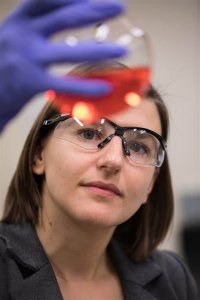Presented By: LSA Biophysics
Using X-ray spectroscopy to understand the role of non-innocent ligands in molecular catalysts
Amy Cordones-Hahn, Staff Scientist, Slac National Accelerator Laboratory, Stanford University

Molecular catalysts based on first row transition metals often employ redox-active or non-innocent ligands to support multi-electron transfer reactions. It can be challenging in these systems to disentangle the roles of ligand-based and metal-based reactive sites in accumulating charge or in bonding with substrates. Reaction mechanisms for these catalysts are therefore often based on computational predictions, with little experimental evidence. X-ray spectroscopy, which probes atomic core level transitions, is a well-suited technique to address these questions. The atomic specificity inherent to x-ray spectroscopy allows one to differentiate metal- or ligand-based reaction sites, the spectra are highly sensitive to both charge distribution and bonding at the specific atomic site, and x-ray measurements can often be conducted in situ or in the time-domain such that isolation of catalyst
species or transient intermediates is not required. My group uses x-ray spectroscopy to investigate the reaction mechanisms of first row transition metal electro- and photo-catalysts containing non-innocent ligands. In particular, we have focused on hydrogen evolving Ni complexes that employ Ni-S coordination. In this seminar, I will describe the progress we’ve made in three areas: (1) New mechanistic insight into the proton reduction reactions of Ni complexes containing pyridinethiolate ligands based on in situ x-ray absorption investigations. (2) How the metal-ligand covalency of Ni catalysts with dithiolene-like ligands can be quantified with x-ray absorption spectroscopy and how it influences reaction mechanism. (3) Finally, how metal-ligand covalency influences the excited state electronic structure and photochemistry of these catalysts.
species or transient intermediates is not required. My group uses x-ray spectroscopy to investigate the reaction mechanisms of first row transition metal electro- and photo-catalysts containing non-innocent ligands. In particular, we have focused on hydrogen evolving Ni complexes that employ Ni-S coordination. In this seminar, I will describe the progress we’ve made in three areas: (1) New mechanistic insight into the proton reduction reactions of Ni complexes containing pyridinethiolate ligands based on in situ x-ray absorption investigations. (2) How the metal-ligand covalency of Ni catalysts with dithiolene-like ligands can be quantified with x-ray absorption spectroscopy and how it influences reaction mechanism. (3) Finally, how metal-ligand covalency influences the excited state electronic structure and photochemistry of these catalysts.